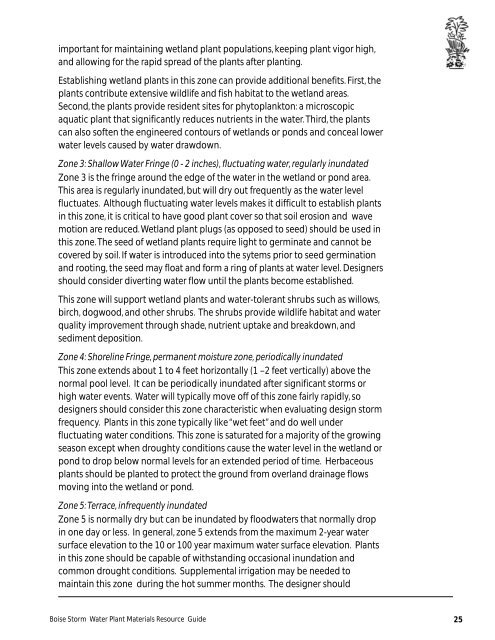Storm Water Plant Materials A Resource Guide
Storm Water Plant Materials A Resource Guide
Storm Water Plant Materials A Resource Guide
You also want an ePaper? Increase the reach of your titles
YUMPU automatically turns print PDFs into web optimized ePapers that Google loves.
important for maintaining wetland plant populations, keeping plant vigor high,<br />
and allowing for the rapid spread of the plants after planting.<br />
Establishing wetland plants in this zone can provide additional benefits. First, the<br />
plants contribute extensive wildlife and fish habitat to the wetland areas.<br />
Second, the plants provide resident sites for phytoplankton: a microscopic<br />
aquatic plant that significantly reduces nutrients in the water. Third, the plants<br />
can also soften the engineered contours of wetlands or ponds and conceal lower<br />
water levels caused by water drawdown.<br />
Zone 3: Shallow <strong>Water</strong> Fringe (0 - 2 inches), fluctuating water, regularly inundated<br />
Zone 3 is the fringe around the edge of the water in the wetland or pond area.<br />
This area is regularly inundated, but will dry out frequently as the water level<br />
fluctuates. Although fluctuating water levels makes it difficult to establish plants<br />
in this zone, it is critical to have good plant cover so that soil erosion and wave<br />
motion are reduced. Wetland plant plugs (as opposed to seed) should be used in<br />
this zone. The seed of wetland plants require light to germinate and cannot be<br />
covered by soil. If water is introduced into the sytems prior to seed germination<br />
and rooting, the seed may float and form a ring of plants at water level. Designers<br />
should consider diverting water flow until the plants become established.<br />
This zone will support wetland plants and water-tolerant shrubs such as willows,<br />
birch, dogwood, and other shrubs. The shrubs provide wildlife habitat and water<br />
quality improvement through shade, nutrient uptake and breakdown, and<br />
sediment deposition.<br />
Zone 4: Shoreline Fringe, permanent moisture zone, periodically inundated<br />
This zone extends about 1 to 4 feet horizontally (1 –2 feet vertically) above the<br />
normal pool level. It can be periodically inundated after significant storms or<br />
high water events. <strong>Water</strong> will typically move off of this zone fairly rapidly, so<br />
designers should consider this zone characteristic when evaluating design storm<br />
frequency. <strong>Plant</strong>s in this zone typically like “wet feet” and do well under<br />
fluctuating water conditions. This zone is saturated for a majority of the growing<br />
season except when droughty conditions cause the water level in the wetland or<br />
pond to drop below normal levels for an extended period of time. Herbaceous<br />
plants should be planted to protect the ground from overland drainage flows<br />
moving into the wetland or pond.<br />
Zone 5: Terrace, infrequently inundated<br />
Zone 5 is normally dry but can be inundated by floodwaters that normally drop<br />
in one day or less. In general, zone 5 extends from the maximum 2-year water<br />
surface elevation to the 10 or 100 year maximum water surface elevation. <strong>Plant</strong>s<br />
in this zone should be capable of withstanding occasional inundation and<br />
common drought conditions. Supplemental irrigation may be needed to<br />
maintain this zone during the hot summer months. The designer should<br />
Boise <strong>Storm</strong> <strong>Water</strong> <strong>Plant</strong> <strong>Materials</strong> <strong>Resource</strong> <strong>Guide</strong><br />
25

















